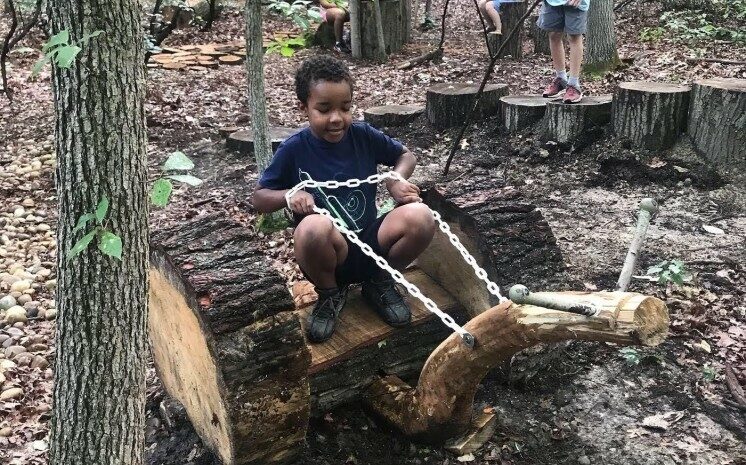Nature Play for Young Explorers

To view the original article, visit the National Estuarine Research Reserve Association website.
September 8, 2019
By: Dolores Leonard
Do you remember a time when a stump could be a kitchen table and a log was a stove? Or a pile of rocks became a fort in an epic neighborhood battle? Or when you discovered the freedom and magic of being outside in nature?
Olivia Wisner can. That’s one reason she worked with the Maryland’s Chesapeake Bay Reserve and their friends group—the Otter Point Creek Alliance (OPCA)—to transform a stand of oaks, tulip poplars, and mountain laurel into a natural discovery area where Harford County kids can have good old unstructured fun and be inspired by the estuary in their backyard.
“At the end of the day, play is the most fundamental kind of learning,” says Wisner, who worked on the project as part of a post undergrad internship with the Chesapeake Conservation Corps. “When I came here, we identified early child education as a gap in Reserve programming. I thought this could help, though we found it’s been fun for much older kids, too!”
Along with being fun, free play in natural setting has been shown to help kids get stronger, more self-confident, and better able to manage risks and focus their attention. Constructed largely from materials on hand near the Reserve’s Anita C. Leight Estuary Center, the discovery area is designed for kids to follow their own interests and energy.
They can jump and balance, engineer a fort, make music, paddle a land-locked canoe, whip up a meal in the nature kitchen, or even put on a show. And if they need some down time, there’s a giant snail to rest and dream on.
The project would not have happened without the support and knowledge that the folks at OPCA provided,” says Wisner. She describes the experience as an “all hands on deck” process in which OPCA volunteers provided grant writing support, helped find supplies, gave advice on construction, and joined other members of the Corps in rolling up their sleeves on construction day.
“We were thrilled to help—this project fits right into our mission to support the Reserve and the Estuary Center, “ says Sharyn Spray, OPCA board chair. “It was something concrete that we could help create. It was completely rewarding to start with some downed trees and a blank slate and have it become a place kids enjoy so much. We look forward to improving it in the future.”
Since the play area opened in June, hundreds of children and young families have taken advantage of this opportunity to connect with the beauty of the Otter Point Creek, including those who participate in the camps supported by the OPCA.
“In 25 years of environmental education, I’ve come to understand you can’t love something unless you get to know it,” says Coreen Weilminster, the education coordinator for the Reserve and one of Olivia’s mentors. “This discovery area is a dedicated space for ‘going off the trail’ to play and think and feel close to nature and animals. It helps kids engage all of their senses outside in a positive, safe way.”
Experiences like this, Weilminster observes, can be a challenge in the area’s schools. Although there is more interest in outdoor programs, often the drive to get kids outside is motivated by individual teachers. When one interested in environmental education leaves a school, the opportunities for kids to get outside can go with them.
“This is one reason why it’s so important for the Reserve and the Center to market and provide field trip opportunities for schools and create outdoor experiences for the public,” says Weilminster.
For Olivia, the experience has affirmed her interest in environmental education and she plans to go right into that field, an outcome that Reserve staff, the OPCA, and the organizers of the Chesapeake Conservation Corps hope for—new leaders ready to take on the challenges of protecting Chesapeake Bay’s environmental resources.
“Building the Nature Discovery Area was an incredible learning experience for me,” says Olivia. “I hope that the space provides a meaningful learning experience for all who visit it.”
